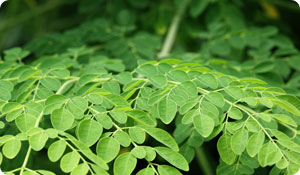
Packed with vitamins, minerals, protein and disease-fighting phytochemicals—nutrients especially lacking in developing countries where diets are deficit—the leaves of the Moringa oleifera tree (also known as the horseradish tree) are a life line. The spindly tree's roots, seeds, bark, and huge flower pods are also edible and nutritious, and valued in these areas for their fiber, oils, and medicinal components. Here's what you need to know about this superfood.
In some parts of Africa, India, and other tropical and subtropical regions, the moringa tree (Moringa oleifera) satisfies hunger and is considered a valuable source of nutrients, medicine, and edible oils that are also used to make soaps and cosmetics. The tree grows very quickly as either an annual or perennial plant. In many of these areas, moringa is not only a commercial crop, but also grown locally in backyards and fields for personal use.
In the United States, agricultural researchers have studied the moringa tree's value and feasibility as a food crop and source of fuel oil. "Moringa is loaded with nutrients, and probably has medicinal value, too" says Jed Fahey, a nutritional biochemist at Johns Hopkins Cullman Chemoprotection Center. "Whether it confers health benefits above and beyond other leafy green vegetables have yet to be determined."
Moringa is sometimes referred to as a "superfood" because it is rich in essential amino acids that make it good source of highly-digestible plant protein, as well as zinc and vitamins C and A in the form of beta carotene. The immature green seed pods of the moringa tree are especially rich in amino acids. When they are young and tender, the pods are cut up and eaten raw, boiled or steamed like zucchini or summer squash. Moringa leaves are also eaten raw in salads or cooked like spinach or kale or any other leafy green vegetable, and used as a side dish or in soups and stews. In Africa, the leaves are dried and turned into a powder that can be sprinkled into food. Pregnant women are encouraged to eat it and it's also commonly added to baby formula. In some areas, the bark is eaten for fiber and the flowers are used to make tea.
"For most people in the United States who have access to highly nutritious vegetables and fruits, it's unlikely that moringa will provide any extra benefit," Fahey points out. "If you eat a balanced, varied diet that includes plenty of leafy dark green vegetables—kale, spinach, broccoli, and collards—you'll get enough of everything moringa has to offer."
Although fresh moringa leaves and pods are not readily available in American markets, some moringa products are sold in Indian and Caribbean markets and through health foods stores in the forms of powder, supplements, and teas. Moringa capsule, powder, and tea is also available through online retailers but as with any supplement or natural remedy, speak with your doctor or someone schooled in the use of moringa before trying it in any of form, especially if you have a medical condition or are pregnant or breastfeeding.
Jed W. Fahey, SCD, a nutritional biochemist at Johns Hopkins, reviewed this article.
Sources:
Fahey, JW. "Moringa oleifera: A Review of the Medical Evidence for Its Nutritonal, Therapeutic, and Prophylactic Properties." Part 1. Trees for Life Journal (published Dec. 2005). Web. Accessed 20 Sep 2013.
http://www.tfljournal.org/article.php/20051201124931586
National Institutes of Health. Thurber M. and Fahey JW. "Adoption of Moringa oleifera to Combat Under-Nutrition Viewed Through the Lens of the Diffusions of Innovations Theory." Ecology of Food and Nutrition 2009 48:212-225. Web. Accessed 20 Sep 2013.
http://www.ncbi.nlm.nih.gov/pmc/articles/PMC2679503/





